INTRODUCTION:
The Microscope of an early Victorian Clergyman:
This is an example of an early achromatic monocular microscope made and retailed during the years 1841-1845 when opticians Abraham Abraham and John Benjamin Dancer were in partnership. It is identical to instruments signed by Abraham alone, an example of which may be seen on Allan Wissner's site. which may postdate their collaboration. It is likely, they also sold this model to the trade as virtually identical microscopes are known which are signed by Carpenter & Westley.
DESCRIPTION:
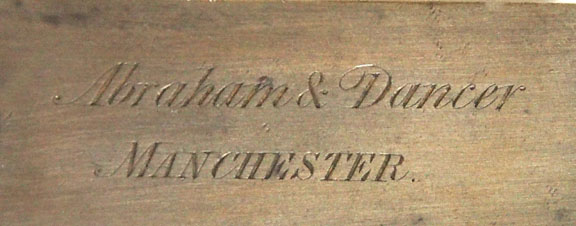
The microscope is all made in brass and is supported by an oxidized-finished tripod foot from which arises a circular pillar with a compass joint at its bottom end, allowing for the instrument to be inclined at any angle. It is signed on the foot: Abraham & Dancer, Manchester
. The pillar stands 176 mm tall and has a rack screwed upon its back. The stage measures 50 x 60 mm and is attached to a ring collar which carries the pinion, which is operated by a single milled head on the right-hand side for the coarse adjustment, thus moving the stage up and down. A knurled knob is located at the top of the pillar for the fine adjustment. The stage is made of oxidized-finished brass and carries a Bonanni-type superstage which is attached with a bayonet fitting.
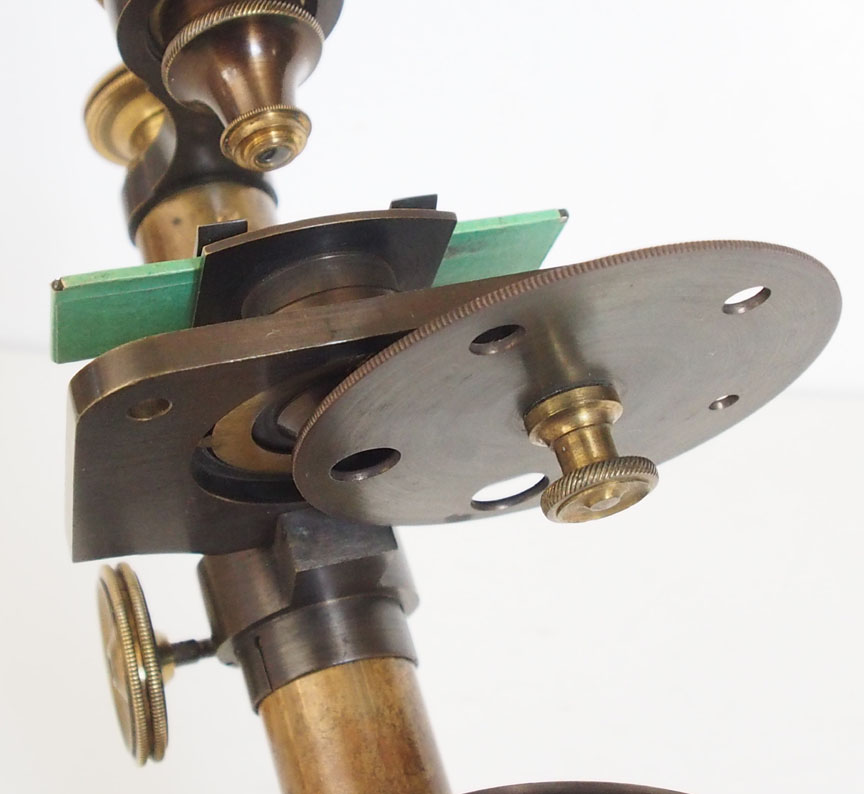
Under the stage is a disc of apertures. There are recesses on the outer corners of the stage which take a stage bullseye condenser and stage forceps. At the top of the pillar is an oxidized brass arm which holds the 145 mm long body tube which has an inner diameter of 28 mm to fit the eye pieces. The lower end of the tube carries the 16.1 diameter 32 T.P.I. thread to fit the objectives, the same as on later Dancer microscopes. At the lower end of the pillar is a sliding ring which carries the gimbal for the single-sided concave mirror. The microscope stands about 340 mm tall when in use.
CASE:
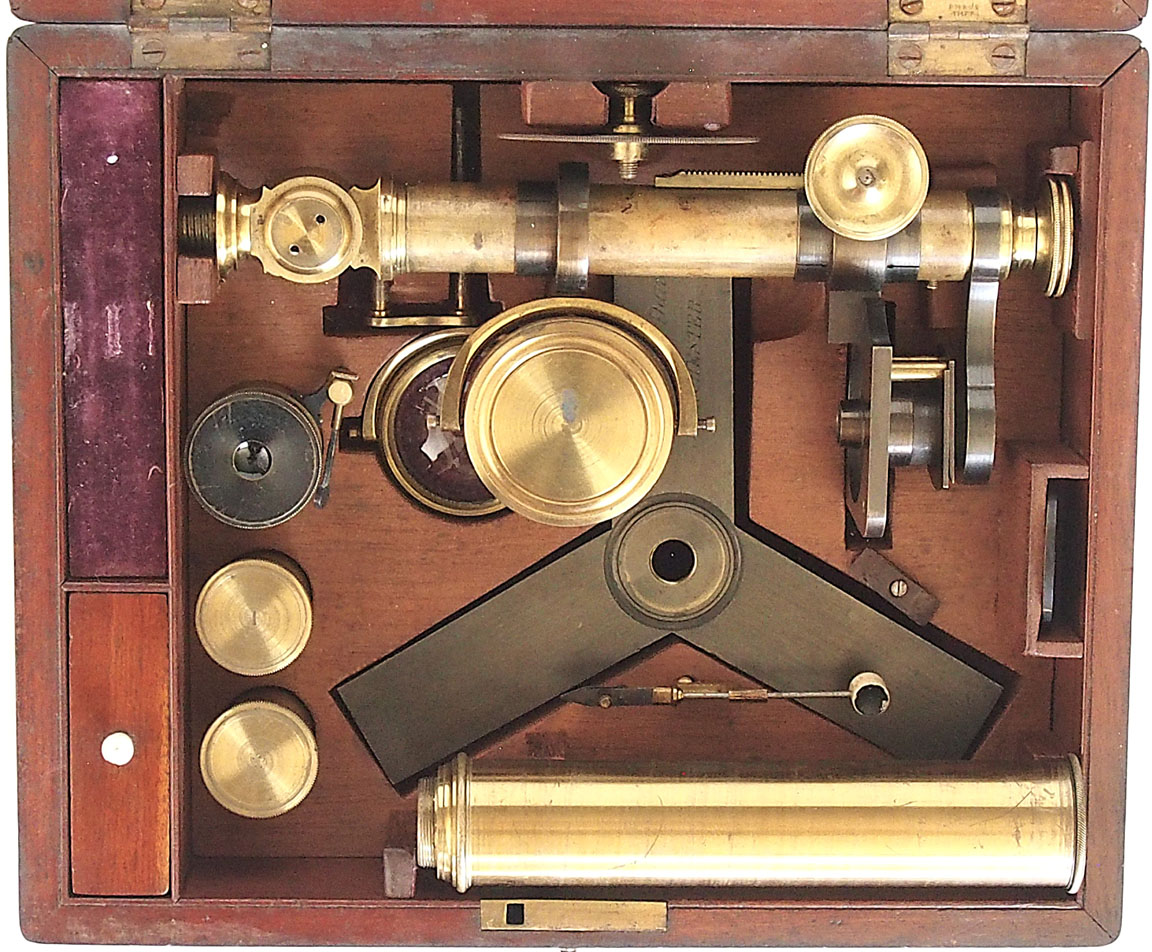
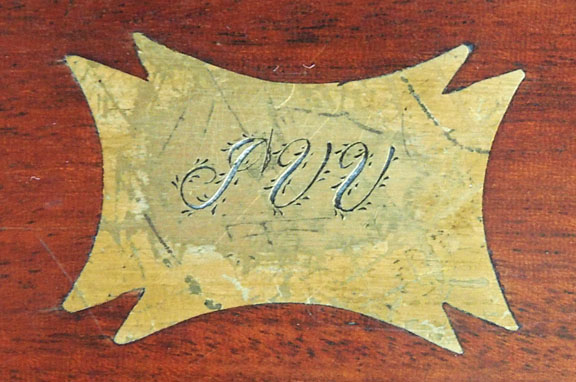 The microscope packs away in a polished mahogany case measuring 253 x 210 x 80 mm. The engraved trade label of Abraham & Dancer is affixed to the inner surface of the lid which features this exact model microscope. The top surface of the case has a small inlaid brass plaque, which is engraved with the initials "J.V-V" (the "J" later scratched to resemble a "P").Inside the case there is a compartment on the left with a purple velvet covered lid, which once held dissection instruments, which are no longer present. There is also a small double sided lift-out drawer with dove-tailed sliding lids containing a number of 56 x 15 mm some of which carry a label reading
The microscope packs away in a polished mahogany case measuring 253 x 210 x 80 mm. The engraved trade label of Abraham & Dancer is affixed to the inner surface of the lid which features this exact model microscope. The top surface of the case has a small inlaid brass plaque, which is engraved with the initials "J.V-V" (the "J" later scratched to resemble a "P").Inside the case there is a compartment on the left with a purple velvet covered lid, which once held dissection instruments, which are no longer present. There is also a small double sided lift-out drawer with dove-tailed sliding lids containing a number of 56 x 15 mm some of which carry a label reading Abraham & Dancer, Opticians, 13 Cross Street, King Street, Manchester
.
ACCESSORIES:
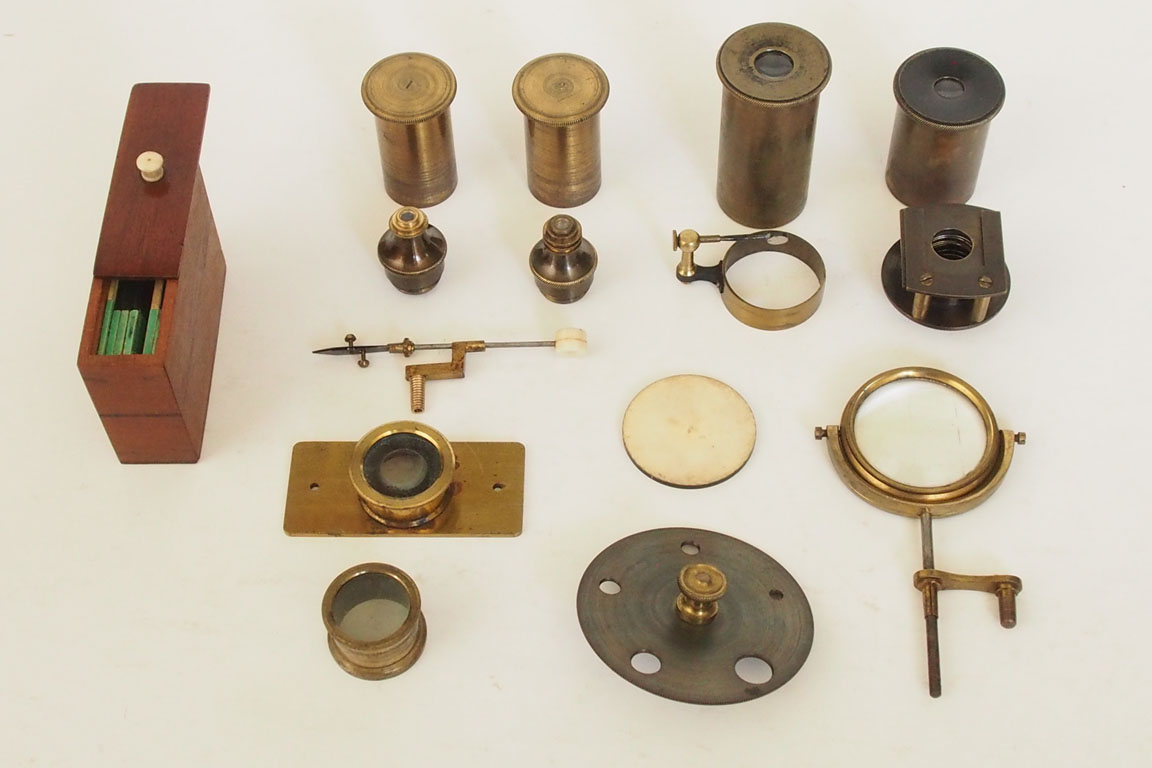
These include two eye pieces with approximate magnifications of x5 and x8, and two objectives in brass cans, their lids marked with "1"and "2". Optical measurements obtained with a stage micrometer and Cheshire apertometer are as follows:
| OBJECTIVE | N.A. | MAG WITH LOW POWER EYEPIECE | MAG WITH HIGHER POWER EYEPIECE |
1 | 0.12 | 45 | 62 |
2 | 0.42 | 220 | 340 |
Other accessories include a stage bullseye condenser on adjustable arm, stage forceps, two live boxes, a
Soemmering-type camera lucida, and a 36 mm diameter disk, one side of which is white, and the other black, for use on the stage as a background for opaque objects.

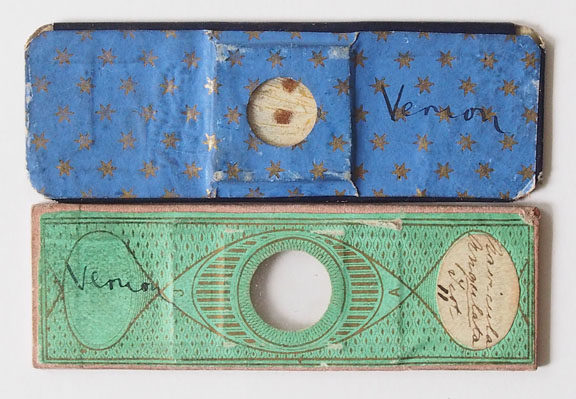
Also with the microscope comes a case measuring 190 x 170 x 32 mm containing a number of 1 x 3 format slides, mostly made by an amateur, presumed to be the original owner, some inscribed in ink "Vernon". The inner lid is covered in red velvet.
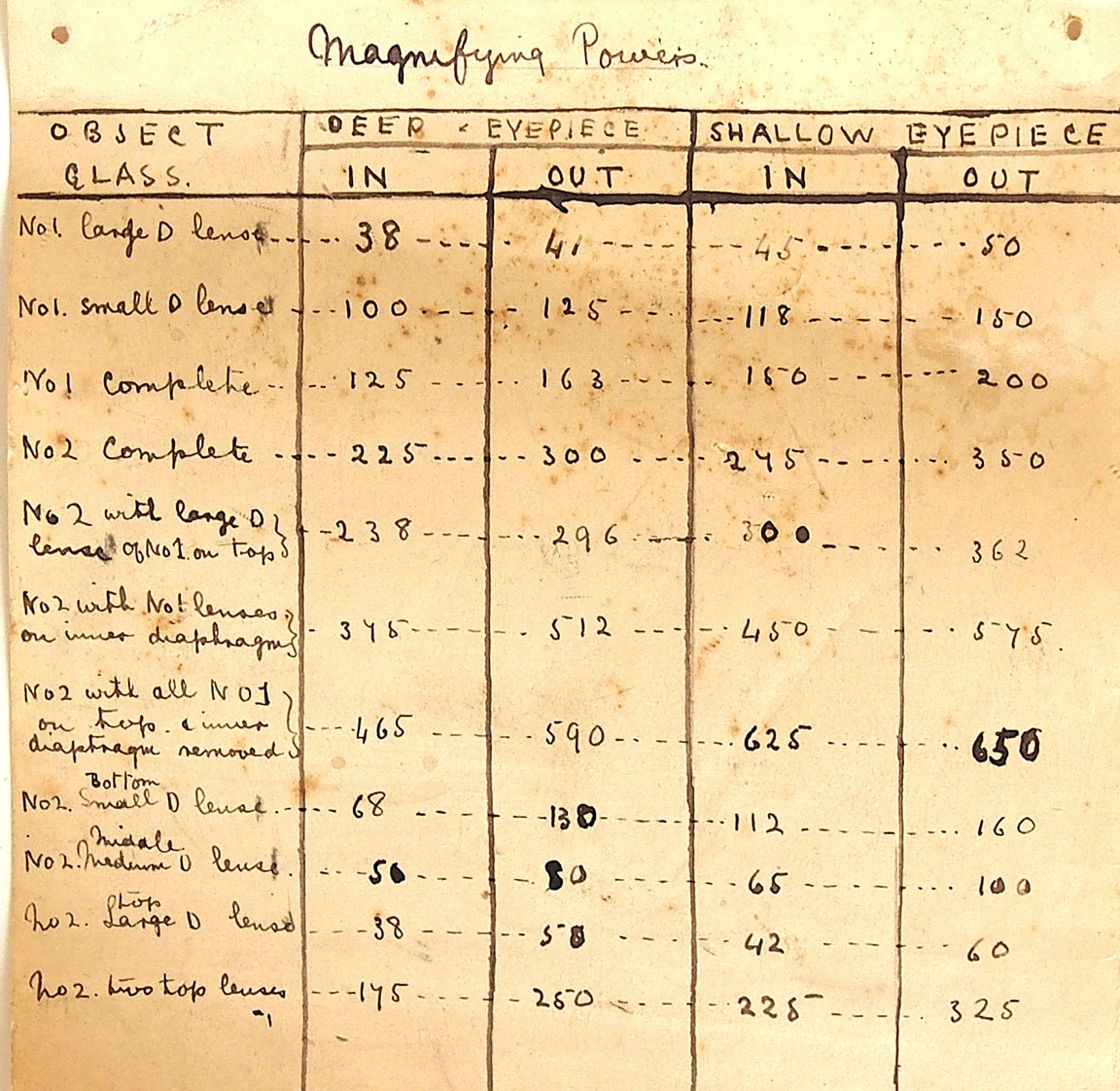
There is also a piece of paper which has written on it in ink the magnifications which can be obtained with the eye pieces and the many ways in which the buttons of both objectives can be combined.
CONDITION:
The microscope is in good original condition with only mild loss of lacquer. Most accessories, except for the dissection instruments are present.
HISTORY:
Abraham Abraham (1799-1863) was the son of an optician from Bath, who established himself in the optical business in Liverpool, first appearing in the business directory there in 1818, and, among other scientific instruments, also sold microscopes. Extant examples include Cary-Gould and Carpenters Improved models which were retailed, but probably not made by him. In 1841 he established a branch of his Liverpool business in Cross street, Manchester in partnership with John Benjamin Dancer, who would later achieve fame as the originator of microphotography. Jacob Abraham, Abraham Abraham's father, had premises mentioned in the local street directories in Bath, and later Cheltenham. Abraham's advertisement announced the reasons for opening the new branch in Manchester in 1841:...at the solicitation of many scientific gentlemen, and upon the conviction that Manchester imperatively requires an establishment to which the manufacture of philosophical and chemical instruments is immediately directed
During this period, Abraham also became involved in some experiments with early Daguerreotype photography in Liverpool, as in Dancer's case in Manchester. His later business partner George S. Wood described later how his late partner and friend, Mr A. Abraham ...was amongst the first opticians to sell cheap achromatic microscopes outside London
. As early as 1841 he sold large numbers complete in a case with two objectives, the lenses obtained from Nachet in France, for only 8 £ per set, capitalizing on the popularity of the new instrument and reaching new markets by forcing the price down.
John Benjamin Dancer came from a line of opticians. His grandfather Michael was based in London from 1766 to his death in 1817, whereupon his son Josiah (1779-1835) moved from London to Liverpool with his son, John Benjamin (1812-1887), who ultimately took over his father's business upon his death in 1835, and in 1841 went into partnership with Abraham Abraham. Dancer was a skilled instrument maker, and it is highly likely that the type of microscope described here was designed and made by him, perhaps using the design of the Carpenter Most Improved model as a starting point, but preferring the version in which the coarse focus moved the stage, and transforming it into a more compact instrument which used imported French button objectives. Their partnership only lasted until 1845, and examples of this model microscope exist which are signed Abraham & Dancer
, whereas others carry only Abraham's name, so, presumably, these may have been sold after their partnership ended. During this period, other variants of this microscope design were made which feature a mechanical stage, and/or a different type of fine focus, which acted on the nose-piece. There is evidence that these were also made for the trade, as some carry the signature of Abraham & Dancer, whereas other identical examples were retailed by Carpenter & Westley.
It is uncertain as to whether their partnership ended under a cloud, as curiously, Dancer says almost nothing about Abraham in his autobiography, except to mention the partnership briefly, but giving no clues as to how they met, or why they parted. Earlier, in 1838, Abraham had opened his first retailing branch in Glasgow, run by Simeon Phineas Cohen, with whom he was in partnership, trading as Abraham & Co, until 1843. In 1851, Abraham was joined in Liverpool by two new partners, both of whom had previously been in business as opticians on their own, Charles West and George Smart Wood. They continued the firm as Abraham & Co for many years, after Abraham had retired.
After the partnership with Abraham ended, J.B. Dancer would continue to produce excellent microscopes of his own design and manufacture, adopting the Jackson type Lister limb. His earlier models featured an optical tube which slid inside an outer tube, and were operated by an internal pinion which was moved by a single milled head on the right-hand side, very much as seen in Powell & Lealand's Student Model
which is often referred to as the Iron
model, because, unlike other P & L microscopes, the Student Model was often made with an iron foot and limb. The first of these were likely sold to the trade, and examples are known which are signed by Carpenter & Westley, and Troughton & Simms, but from 1848 onwards, these microscopes are inscribed with Dancer's own name. By now, these no longer have a Varley stage, but feature a mechanical stage with diagonal movements of Dancer's own concept, as illustrated by an example on this site. Somewhat later, Dancer adopted a dovetailed groove inside the arm, in the manner of Smith and Beck, the pinion now operated by two knurled knobs, a design which would become a permanent feature on microscopes from that point onwards.
THE ORIGINAL OWNER
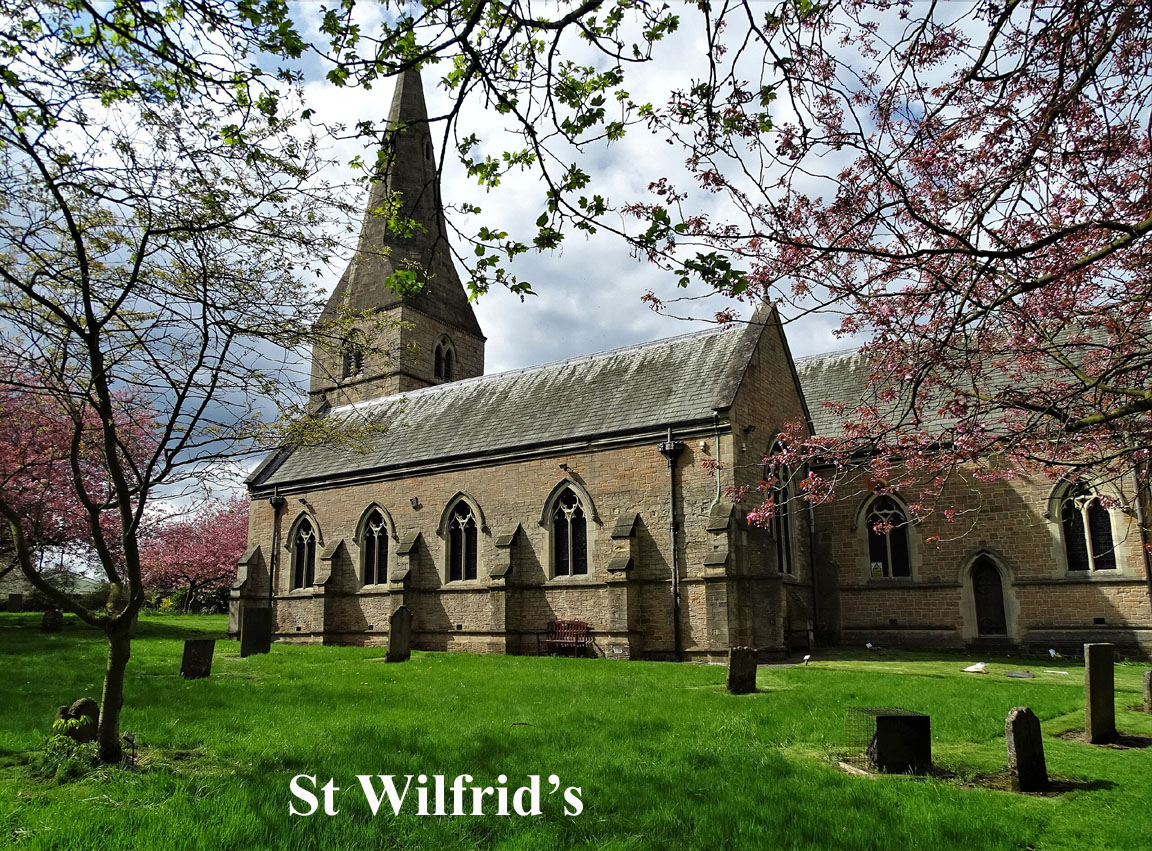
It has come to light that the original owner of this microscope was one Reverend John Edward Venables-Vernon (8/3/1798-12/12/1875) an English clergyman, who from 1829 to his death was the rector of St Wilfrid's Anglican church(left) of Kirkby in Ashfield, Nottinghamshire, England. The microscope comes with a case of amateur slides probably made by the owner, as per the inscription Vernon
on some of the slides. His wife was Frances Barbara Venables-Vernon (d.7/12/1848), born Duncombe. They had only one child, a son who died in infancy, so the microscope may have gone to a surviving relative with the initial 'P' upon the reverend's death in 1875, as per the scratched alteration on the lid of the case. John Edward V-V was the son of Henry Venables-Vernon, 3d baron Vernon (1747-1829), and Alice Lucy V-V , born Whiteford (1771-1827). He obtained a B.A. degree at Oxford and was ordained Deacon (Christchurch) on 16/11/1821, and priest on 31/3/1822. His religious appointments included Rector: Molesworth 31/3/1822-29/12/1826; Barton in Fabis 18/8/1826-3/6/1829, Canon : Southwell Minster, prebend of Durham 14/10/1826- 3/8/1829 and Rector Of Kirkby in Ashfield from 1829 until his death.
In this earlier part of the 19th century, it was not uncommon for clergymen to have an interest in science, and many developed an interest in microscopy, as did the Rev. Dallinger (see web page on the Powell & Lealand No 1), which enabled them to study the work of the creator
in minute detail (before Darwin cast doubt on the mechanisms of the creation itself). This Abraham and Dancer microscope would have been one of the earliest then available for sale outside of London, in Manchester, some 70 miles away. We can speculate that the reverend may not have travelled to Abraham & Dancer's opticians' shop by carriage, but may have seen their microscopes advertised in the newspaper, sent the money, and had the microscope delivered to the rectory by stage coach.
REFERENCES
Stevenson, B. Abraham Abraham... in Microscopist.net Accessed 2025.
Butler, S. Microscopes in Manchester. Microscopy 35 July-December 1987. 570-580.
Clifton, G. Directory of British Scientific Instrument makers 1550-1851. Zwemmer.1995.
Jones, G. Under the Microscope. Science, religion and the Origin of Life, through the eyes of Victorian England. Berberis Books.2019
Morrison-Low, A.D. Making Scientific Instruments in the Industrial Revolution. National Museums of Scotland. Ashgate. 2007
Nuttall, R.H. Microscopes from the Frank collection. A. Frank, Jersey, Channel Islands, 1979
Quekett, J. A Practical Treatise on the use of the Microscope, 3d edition, 1855. H. Bailliere, London.
Tither, R. An Achromatic Microscope by Abraham & Dancer c. 1841-1845. Microscopy 31, May 1969; 150-158.



 The microscope packs away in a polished mahogany case measuring 253 x 210 x 80 mm. The engraved trade label of Abraham & Dancer is affixed to the inner surface of the lid which features this exact model microscope. The top surface of the case has a small inlaid brass plaque, which is engraved with the initials "J.V-V" (the "J" later scratched to resemble a "P").Inside the case there is a compartment on the left with a purple velvet covered lid, which once held dissection instruments, which are no longer present. There is also a small double sided lift-out drawer with dove-tailed sliding lids containing a number of 56 x 15 mm some of which carry a label reading
The microscope packs away in a polished mahogany case measuring 253 x 210 x 80 mm. The engraved trade label of Abraham & Dancer is affixed to the inner surface of the lid which features this exact model microscope. The top surface of the case has a small inlaid brass plaque, which is engraved with the initials "J.V-V" (the "J" later scratched to resemble a "P").Inside the case there is a compartment on the left with a purple velvet covered lid, which once held dissection instruments, which are no longer present. There is also a small double sided lift-out drawer with dove-tailed sliding lids containing a number of 56 x 15 mm some of which carry a label reading 



